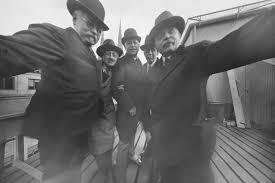In today’s era of smartphones and social media, selfies have become a ubiquitous part of our lives. We snap them effortlessly, capturing moments and expressions to share with friends and followers. But have you ever wondered about the origins of the selfie? In this blog post, we will delve into the intriguing story behind the first selfie and how it has shaped the way we perceive and document ourselves.
I. The Dawn of Self-Portraiture:
- Early Self-Portraits: Self-portraits have a long history dating back centuries. Artists such as Rembrandt and Van Gogh created self-portraits as a means of self-expression and exploration.
- Technological Advances: The invention of photography in the 19th century brought about a new way of capturing self-images. However, taking a self-portrait was still a complex process that required long exposure times and careful positioning.
II. The First Selfie: A Historic Moment:
- Robert Cornelius: The first recognized selfie was taken by Robert Cornelius in 1839. Cornelius, an amateur chemist and photography enthusiast, positioned himself in front of the camera lens for a duration of several minutes to capture his own likeness.
- Daguerreotype: Cornelius used the daguerreotype process, an early photographic technique that required the subject to remain still for an extended period. His self-portrait marked a significant milestone in the history of photography and set the stage for future self-imaging practices.
III. Evolution of Selfie Culture:
- Technological Advancements: As photography evolved and became more accessible to the masses, so did the ability to take self-portraits. The introduction of point-and-shoot cameras and later smartphones with front-facing cameras made it easier than ever to capture selfies.
- Social Media Influence: The rise of social media platforms like Instagram, Facebook, and Snapchat played a pivotal role in popularizing the selfie. The ability to instantly share self-images with a wide audience led to the exponential growth of selfie culture.
IV. The Psychology Behind Selfies:
- Self-Expression and Identity: Selfies provide a means for individuals to express themselves, showcase their creativity, and shape their online personas.
- Empowerment and Body Positivity: Selfies have become a powerful tool for promoting body positivity and self-acceptance. By taking control of their self-image, individuals can challenge societal beauty standards and celebrate their unique identities.
- Validation and Connection: Likes, comments, and shares on social media platforms can provide a sense of validation and connection, reinforcing self-esteem and social bonds.
V. The Selfie Phenomenon:
- Selfie Culture and Criticism: The proliferation of selfies has generated both praise and criticism. Some argue that selfies promote narcissism and shallow self-obsession, while others see them as a form of self-empowerment and self-documentation.
- Influence on Popular Culture: Selfies have become ingrained in popular culture, shaping trends, fashion, and even political movements. Celebrities, influencers, and brands utilize selfies as a marketing tool, further fueling their popularity.
Conclusion: The first selfie by Robert Cornelius in 1839 marked the beginning of a new era in self-portraiture. From the painstaking process of early photography to the convenience of today’s smartphones, selfies have evolved into a cultural phenomenon. They provide a platform for self-expression, self-empowerment, and connection in our increasingly digital world. So, the next time you capture a selfie, take a moment to appreciate the historical significance and the ongoing narrative that your self-image contributes to.
References:
- “Selfies: Self-Portrait Photography with Attitude” by Haje Jan Kamps
- “The Power of Selfies: How Self-Expressions Is Changing Our Lives” by Nancy Jo Sales
- “The Art of the Selfie: A Modern-Day Look at Photography and How We Share Our Lives Online” by Lindsay D. Rogers
I hope this blog post on the first selfie provides you with the information you were seeking. If you need further assistance or have any other topic in mind, please let me know.



















Add Comment